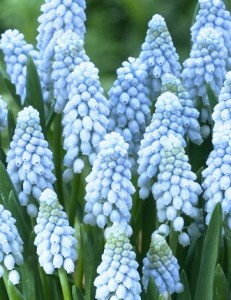I saw the season’s first grape hyacinth yesterday. It was a little early, but clearly it was positioned in the best possible spot and flowered bravely despite making an appearance on a day when temperatures were more wintery than spring-like. Had I been willing to get down on my knees to sniff its small flowerhead, I would have caught just a hint of the characteristic sweet muscari fragrance.
The brave grape hyacinth was a common one, known botanically as Muscari armeniacum, or, in some sources, Muscari botryoides. A certain amount of name-related confusion seems to reign in the horticulture trade, but common “grape hyacinths” are characterized by “grapes”, which are dark, blue-purple bell-shaped flowers clustered into a tight, narrow cones at the top of each slender stalk. Theoretically, grape hyacinths grow between six and eight inches tall. The one I spotted was barely four inches, probably owing to its early-rising nature. As the weather warms up, it will be joined by scores of somewhat taller grape hyacinth siblings, because grape hyacinths are nothing if not prolific.
Like daffodils and some other well-loved spring-flowering plants, grape hyacinths are long-lived. Established clumps, left on their own, will naturalize and often outlive the individuals who planted them. You can also dig up a clump and take them with you when you move from one house to another. Positioned in a sunny spot, or even under a deciduous tree, the clump will start the business of making itself at home immediately and reproduce without any intervention at all.
If you look closely at grape hyacinth family relationships, you will find the genus Muscari is part of the Asparagaceae family, home to that other spring favorite, edible asparagus. Both are harbingers of spring, but other similarities are obvious only to plant taxonomists and geneticists. Muscari armeniacum, not surprisingly, hails originally from Armenia and other parts of southeastern Europe. Garden and plant historian Denise Wyles Adams says that the plants were introduced in 1596, which means that they have been around in domestic cultivation somewhere (probably in Europe, as well as their native areas) since long before that.
Anything that has been popular for as long as grape hyacinth will have attracted the attention of amateur and professional plant breeders. Plant merchandisers carry lots of varieties every fall. I am very partial to ‘Valerie Finnis’, which is big—sometimes as tall as eight inches—bold, and pale blue, making a nice contrast with its darker relations. ‘Baby’s Breath’ is an even lighter shade. If pink is your cup of tea, try ‘Pink Sunrise’. White-flowered varieties like ‘Siberian Tiger’ also play well with grape hyacinths in other shades.
In the bi-colored domain, ‘Touch of Snow’ is dark blue-purple with a lighter blue floral topknot.
Some people must have double everything, and for them, merchandisers carry varieties like ‘Blue Spike’, which looks the way I imagine a normal grape hyacinth would look if you stuck the end of the stalk in a live electrical outlet. Another double with bi-colored blue and white flowers is ‘Double Beauty’.
Muscari armeniacum is not the only muscari species around. Muscari azureum features slightly looser flowerheads striped in pale and darker blue. The unfortunately named Muscari neglectum is a tri-color, with lower florets that are purple-black edged in white, and upper florets of lighter blue-lavender. Muscari macrocarpum ‘Golden Fragrance’ is true to its varietal name, with lower bell-shaped florets of yellow-gold and topknots of purple.
While the number of grape hyacinth varieties is not endless, it is certainly large. Once you have identified varieties that you like, the most important thing to remember is to buy lots of bulbs. I would start with at least 50 and plant them in odd numbered groups in locations where they will be easy to see. The edges of garden beds are excellent spots, as are rock gardens or containers. The ephemeral nature of the flowers and foliage means that the whole grape hyacinth show will be over by the end of spring, so they can easily make way for larger plants.
Though grape hyacinths are fall-planted bulbs, it pays to think about them now. At about the same time as this year’s foliage begins to go brown, vendors will be sending out the first of the fall bulb catalogs. Get a jump on next year’s spring display by ordering early. Van Engelen/Scheepers has a good selection. Find them at 23 Tulip Drive, P.O. Box 638, Bantam, CT 06750; (860) 567-8734; www.vanengelen.com. Another great source is Brent and Becky’s Bulbs, 7900 Daffodil Lane | Gloucester, VA 23061; (877) 661-2852; www.brentandbeckysbulbs.com. Both companies offer print catalogs.

